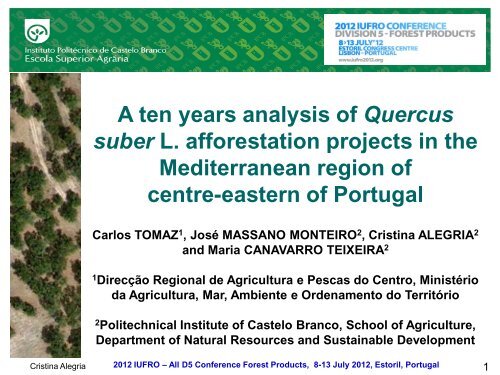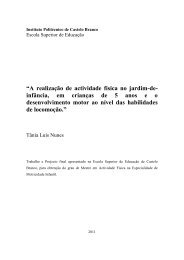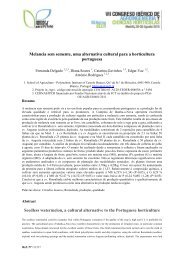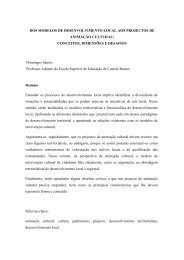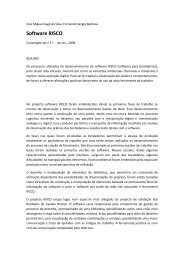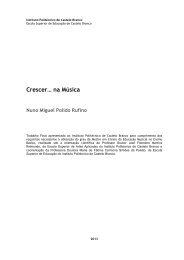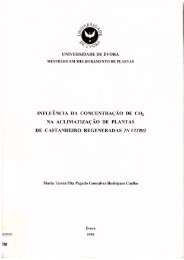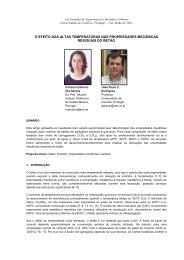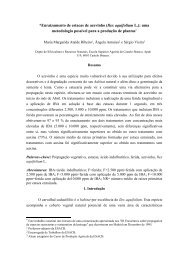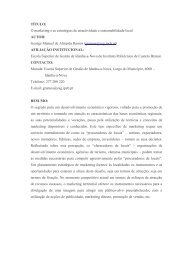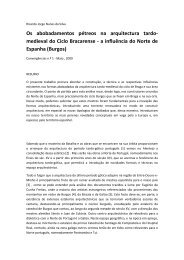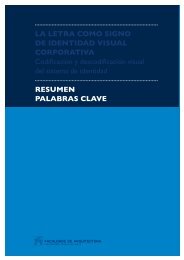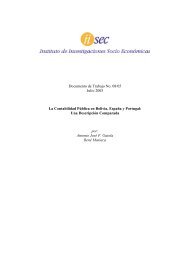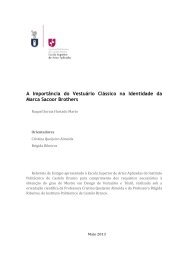A ten years analysis of Quercus suber L. afforestation projects in the ...
A ten years analysis of Quercus suber L. afforestation projects in the ...
A ten years analysis of Quercus suber L. afforestation projects in the ...
Create successful ePaper yourself
Turn your PDF publications into a flip-book with our unique Google optimized e-Paper software.
A <strong>ten</strong> <strong>years</strong> <strong>analysis</strong> <strong>of</strong> <strong>Quercus</strong><br />
<strong>suber</strong> L. <strong>afforestation</strong> <strong>projects</strong> <strong>in</strong> <strong>the</strong><br />
Mediterranean region <strong>of</strong><br />
centre-eastern <strong>of</strong> Portugal<br />
Carlos TOMAZ 1 , José MASSANO MONTEIRO 2 , Crist<strong>in</strong>a ALEGRIA 2<br />
and Maria CANAVARRO TEIXEIRA 2<br />
1<br />
Direcção Regional de Agricultura e Pescas do Centro, M<strong>in</strong>istério<br />
da Agricultura, Mar, Ambiente e Ordenamento do Território<br />
2<br />
Politechnical Institute <strong>of</strong> Castelo Branco, School <strong>of</strong> Agriculture,<br />
Department <strong>of</strong> Natural Resources and Susta<strong>in</strong>able Development<br />
Crist<strong>in</strong>a Alegria 2012 IUFRO – All D5 Conference Forest Products, 8-13 July 2012, Estoril, Portugal 1
Introduction<br />
The aim <strong>of</strong> this study was to analyze <strong>the</strong> implementation <strong>of</strong> <strong>the</strong><br />
“Afforestation <strong>of</strong> Agricultural Land” programme (RURIS-AAL) <strong>in</strong> a<br />
Mediterranean region <strong>of</strong> Portugal, with some desertification problems.<br />
The programme had two monitor<strong>in</strong>g moments, until now:<br />
- Stands establishment stage: dur<strong>in</strong>g 2000 - 2006<br />
- Stands ma<strong>in</strong><strong>ten</strong>ance stage: 1 st dur<strong>in</strong>g 2006 - 2011.<br />
Based on <strong>the</strong> data collected dur<strong>in</strong>g field monitor<strong>in</strong>g campaigns, <strong>the</strong><br />
possible causes for both successful and unsuccessful <strong>afforestation</strong><br />
were explored.<br />
Crist<strong>in</strong>a Alegria 2012 IUFRO – All D5 Conference Forest Products, 8-13 July 2012, Estoril, Portugal 2
Methods<br />
Study area Mediterranean region <strong>of</strong> centre-eastern <strong>of</strong> Portugal<br />
BIS - Beira Interior Sul<br />
Fig. 1 Study area geographical location<br />
Crist<strong>in</strong>a Alegria 2012 IUFRO – All D5 Conference Forest Products, 8-13 July 2012, Estoril, Portugal 3
Data<br />
The <strong>in</strong>formation was obta<strong>in</strong>ed <strong>in</strong> 164 <strong>afforestation</strong> <strong>projects</strong> established <strong>in</strong><br />
marg<strong>in</strong>al or abandoned agricultural areas.<br />
(a)<br />
Afforestation area <strong>of</strong> 3363.04 ha.<br />
(b)<br />
Fig. 2 a) land cover <strong>in</strong> 2000; b) <strong>projects</strong><br />
Crist<strong>in</strong>a Alegria 2012 IUFRO – All D5 Conference Forest Products, 8-13 July 2012, Estoril, Portugal 4
Pp<br />
Pn<br />
Qs<br />
Qr<br />
B<br />
PpQ<br />
PnQs<br />
PnQr<br />
QsQr<br />
QsPp<br />
QsCu<br />
QsB<br />
BB<br />
Afforestation <strong>projects</strong> (164)<br />
pure cork oak stands (54%)<br />
• Coniferous<br />
Pp – P<strong>in</strong>us p<strong>in</strong>aster<br />
Pn – P<strong>in</strong>us p<strong>in</strong>ea<br />
Area (ha)<br />
2000<br />
1800<br />
1600<br />
1400<br />
1200<br />
1000<br />
800<br />
600<br />
400<br />
200<br />
0<br />
mixed stands <strong>of</strong><br />
cork oak (31%)<br />
Fig. 3 Species<br />
Projects<br />
Samples<br />
• Broadleaves<br />
Qs – <strong>Quercus</strong> <strong>suber</strong><br />
Qr – <strong>Quercus</strong> rotundifolia<br />
B – o<strong>the</strong>r wood broadleaves (Frax<strong>in</strong>us sp.,<br />
Castanea sativa, Juglans nigra, Prunus<br />
avium)<br />
• Mixed<br />
PpQ – P<strong>in</strong>us p<strong>in</strong>aster x <strong>Quercus</strong> sp.<br />
PnQs – P<strong>in</strong>us p<strong>in</strong>ea x <strong>Quercus</strong> <strong>suber</strong><br />
PnQr – P<strong>in</strong>us p<strong>in</strong>ea x <strong>Quercus</strong> rotundifolia<br />
QsQr – <strong>Quercus</strong> <strong>suber</strong> x <strong>Quercus</strong><br />
rotundifolia<br />
QsPp – <strong>Quercus</strong> <strong>suber</strong> x P<strong>in</strong>us p<strong>in</strong>aster<br />
QsCu – <strong>Quercus</strong> <strong>suber</strong> x Cupressus sp.<br />
QsB – mixed <strong>of</strong> cork oak with broad-leaved<br />
BB – mixed <strong>of</strong> wood broadleaves<br />
Crist<strong>in</strong>a Alegria 2012 IUFRO – All D5 Conference Forest Products, 8-13 July 2012, Estoril, Portugal 5
Pp<br />
Pn<br />
Qs<br />
Qr<br />
B<br />
PpQ<br />
PnQs<br />
PnQr<br />
QsQr<br />
QsPp<br />
QsCu<br />
QsB<br />
BB<br />
Field samples (158 – 64 <strong>projects</strong>)<br />
Field samples: randow sampl<strong>in</strong>g; <strong>in</strong><strong>ten</strong>sity accord<strong>in</strong>g to project area and<br />
site variability (stand density).<br />
pure cork oak stands (48%)<br />
2000<br />
Area (ha)<br />
1800<br />
1600<br />
1400<br />
1200<br />
1000<br />
800<br />
600<br />
400<br />
200<br />
0<br />
mixed stands <strong>of</strong><br />
cork oak (32%)<br />
Projects<br />
Samples<br />
164 - 3363.04 ha<br />
97 - 1640.75 ha<br />
Fig. 4 Projects Species and field samples<br />
Crist<strong>in</strong>a Alegria 2012 IUFRO – All D5 Conference Forest Products, 8-13 July 2012, Estoril, Portugal 6
Information<br />
It was collected <strong>in</strong>formation about stand density (N – number <strong>of</strong> trees<br />
per ha) to assess if m<strong>in</strong>imum stand density was observed.<br />
And, as well, some additional <strong>in</strong>formation concern<strong>in</strong>g to:<br />
- previous land cover,<br />
- stand regeneration,<br />
- site preparation,<br />
- species,<br />
- stand composition,<br />
- elevation,<br />
- soil type and depth,<br />
- <strong>in</strong>dividual tree protection,<br />
- fences,<br />
- animal damage<br />
Crist<strong>in</strong>a Alegria 2012 IUFRO – All D5 Conference Forest Products, 8-13 July 2012, Estoril, Portugal 7
Table 1 Variables and cod<strong>in</strong>g<br />
Code<br />
Previous Land<br />
Soil<br />
Soil<br />
Altimetry<br />
Site<br />
Seedl<strong>in</strong>gs<br />
Animal<br />
Cover<br />
type<br />
depth<br />
level Species Composition<br />
preparation<br />
protection<br />
damage<br />
1<br />
OO<br />
Sa<br />
S<br />
B<br />
Pp<br />
P<br />
MCRB<br />
N<br />
N<br />
2<br />
NIA<br />
Sc<br />
M<br />
sM<br />
Pn<br />
M<br />
MCS<br />
Y<br />
Y<br />
3<br />
NG<br />
Gr<br />
D<br />
M<br />
Qs<br />
MCB<br />
4<br />
5<br />
6<br />
F<br />
Sa – sandstone<br />
Sc – schist<br />
Gr – granite<br />
Qr<br />
B<br />
QsQr<br />
P – pure<br />
N – mixed<br />
MCHP<br />
NCT<br />
RP<br />
Y – yes<br />
N – no<br />
7<br />
8<br />
9<br />
OG – olive groves<br />
NIA – non-irrigated arable land<br />
NG – natural grassland<br />
F – forests<br />
S – superficial<br />
M – medium<br />
D – deep<br />
QSPp/PnQs<br />
Crist<strong>in</strong>a Alegria 2012 IUFRO – All D5 Conference Forest Products, 8-13 July 2012, Estoril, Portugal 8<br />
PnQr<br />
BB/PpQ<br />
B - basal (0-400 m)<br />
sM – sub-montane (400-700 m)<br />
M – montane (700-1000 m)<br />
RB<br />
S<br />
MCRB – mechanical clear<strong>in</strong>g, ripp<strong>in</strong>g and bedd<strong>in</strong>g<br />
MCS – mechanical clear<strong>in</strong>g and subsoil<strong>in</strong>g<br />
MCB – mechanical clear<strong>in</strong>g and bedd<strong>in</strong>g<br />
MCPH – manual clear<strong>in</strong>g and plant<strong>in</strong>g holes<br />
NCT – non-commercial th<strong>in</strong>n<strong>in</strong>g<br />
RP – ripp<strong>in</strong>g and plow<strong>in</strong>g<br />
RB – ripp<strong>in</strong>g and bedd<strong>in</strong>g<br />
S – subsoil<strong>in</strong>g
Methodology<br />
Field samples - project status<br />
• Regular<br />
• Irregular - Lack <strong>of</strong> m<strong>in</strong>imum stand density<br />
- Deficiencies meet<strong>in</strong>g management plan goals<br />
Pr<strong>in</strong>cipal Components Analysis (PCA) was used to f<strong>in</strong>d out, which<br />
variables were <strong>the</strong> most important on expla<strong>in</strong><strong>in</strong>g:<br />
- <strong>afforestation</strong> success (samples with regular status) and<br />
- <strong>afforestation</strong> success failure (samples with irregular status due to lack<br />
<strong>of</strong> m<strong>in</strong>imum stand density)<br />
and how <strong>the</strong>se variables were correlated.<br />
Crist<strong>in</strong>a Alegria 2012 IUFRO – All D5 Conference Forest Products, 8-13 July 2012, Estoril, Portugal 9
Area (ha)<br />
Pp<br />
Ec<br />
Qs<br />
Qr<br />
Q<br />
Pn<br />
Cs<br />
C<br />
B<br />
Results<br />
Forest area <strong>in</strong> BIS region<br />
(a)<br />
National Forest Inventory<br />
2005/06<br />
(b)<br />
CLC 2006<br />
BIS<br />
60000<br />
50000<br />
40000<br />
30000<br />
20000<br />
10000<br />
0<br />
Species<br />
Fig. 5 Forests: a) National Forest Inventory - species areas; b) CLC 2006 - Forests<br />
Crist<strong>in</strong>a Alegria 2012 IUFRO – All D5 Conference Forest Products, 8-13 July 2012, Estoril, Portugal 10
Table 2 Afforestation <strong>projects</strong><br />
Previous Land<br />
% Soil<br />
% Soil<br />
% Altimetry<br />
% Site<br />
% Seedl<strong>in</strong>gs<br />
% Animal<br />
%<br />
Cover<br />
type<br />
depth<br />
level<br />
preparation<br />
protection<br />
damage<br />
OO<br />
NIA<br />
5<br />
25<br />
Sa<br />
Sc<br />
5<br />
71<br />
S<br />
M<br />
62<br />
32<br />
B<br />
sM<br />
60<br />
39<br />
MCRB<br />
MCS<br />
36.2<br />
0.4<br />
N<br />
Y<br />
v<br />
34<br />
66<br />
N<br />
Y<br />
21<br />
69<br />
NG<br />
67<br />
Gr<br />
24<br />
D<br />
2<br />
M<br />
2<br />
MCB<br />
1.9<br />
F<br />
3<br />
MCHP<br />
0.2<br />
NCT<br />
3.0<br />
RP<br />
7.5<br />
RB<br />
39.5<br />
OG – olive groves<br />
NIA – non-irrigated arable land<br />
NG – natural grassland<br />
F – forests<br />
S – superficial<br />
M – medium<br />
D – deep<br />
MCRB – mechanical clear<strong>in</strong>g, ripp<strong>in</strong>g and bedd<strong>in</strong>g<br />
MCS – mechanical clear<strong>in</strong>g and subsoil<strong>in</strong>g<br />
MCB – mechanical clear<strong>in</strong>g and bedd<strong>in</strong>g<br />
MCPH – manual clear<strong>in</strong>g and plant<strong>in</strong>g holes<br />
NCT – non-commercial th<strong>in</strong>n<strong>in</strong>g<br />
Sa – sandstone B - basal (0-400 m)<br />
RP – ripp<strong>in</strong>g and plow<strong>in</strong>g<br />
Sc – schist<br />
sM – sub-montane (400-700 m) RB – ripp<strong>in</strong>g and bedd<strong>in</strong>g<br />
Gr – granite<br />
M – montane (700-1000 m) S – subsoil<strong>in</strong>g<br />
Crist<strong>in</strong>a Alegria 2012 IUFRO – All D5 Conference Forest Products, 8-13 July 2012, Estoril, Portugal 11<br />
S<br />
11.3
Field samples area (ha)<br />
1400<br />
1200<br />
1000<br />
800<br />
600<br />
400<br />
• Regular status (76%)<br />
• Lack <strong>of</strong> m<strong>in</strong>imum stand density (10%)<br />
• Deficiencies meet<strong>in</strong>g management plan goals (13%)<br />
200<br />
0<br />
Stand<br />
density<br />
Plan<br />
Regular<br />
Irregular<br />
Status<br />
Fig. 6 Afforestation <strong>projects</strong> status<br />
Crist<strong>in</strong>a Alegria 2012 IUFRO – All D5 Conference Forest Products, 8-13 July 2012, Estoril, Portugal 12
Area (ha)<br />
Pp<br />
Pn<br />
Qr<br />
Qs<br />
B<br />
PpQ<br />
PnQs<br />
PnQr<br />
QsQr<br />
QsPp<br />
QsCu<br />
QsB<br />
BB<br />
1000<br />
900<br />
800<br />
700<br />
600<br />
500<br />
400<br />
300<br />
200<br />
100<br />
0<br />
• Regular status (%)<br />
pure cork oak<br />
stands<br />
79%<br />
95% 85%<br />
Plan irregular<br />
N irregular<br />
Regular<br />
76%<br />
mixed stands <strong>of</strong> cork oak<br />
species<br />
Fig. 7 Projects status – field samples areas<br />
Crist<strong>in</strong>a Alegria 2012 IUFRO – All D5 Conference Forest Products, 8-13 July 2012, Estoril, Portugal 13
Afforestation success and failure<br />
PCA 1 st and 2 nd pr<strong>in</strong>cipal components - expla<strong>in</strong>ed around 50% <strong>of</strong> data<br />
variability<br />
Fig. 8 PCA – Field samples with regular status<br />
PCA clearly <strong>in</strong>dicates that <strong>the</strong>:<br />
• 1 st component is related to stand establishment conditions;<br />
• 2 nd component is related to site conditions.<br />
Crist<strong>in</strong>a Alegria 2012 IUFRO – All D5 Conference Forest Products, 8-13 July 2012, Estoril, Portugal 14
Code Site<br />
Animal<br />
Code<br />
Seedl<strong>in</strong>gs<br />
preparation<br />
damage<br />
Species<br />
protection<br />
1<br />
MCRB<br />
N<br />
1<br />
Pp<br />
P<br />
N<br />
2<br />
MCS<br />
Y<br />
2<br />
Pn<br />
M<br />
Y<br />
3<br />
MCB<br />
3<br />
Qs<br />
4<br />
MCHP<br />
4<br />
Qr<br />
5<br />
NCT<br />
5<br />
B<br />
6<br />
RP<br />
6<br />
QsQr<br />
7<br />
RB<br />
7<br />
QSPp/PnQs<br />
8<br />
S<br />
8<br />
PnQr<br />
9<br />
BB/PpQ<br />
Site preparation and animal damage were found to be negatively<br />
correlated to regular status samples. Species, composition and<br />
seedl<strong>in</strong>gs protection were found to be positively correlated.<br />
Crist<strong>in</strong>a Alegria 2012 IUFRO – All D5 Conference Forest Products, 8-13 July 2012, Estoril, Portugal 15
Code<br />
1<br />
2<br />
3<br />
Soil<br />
type<br />
Sa<br />
Sc<br />
Gr<br />
Soil<br />
depth<br />
S<br />
M<br />
D<br />
Code<br />
Previous<br />
1<br />
2<br />
3<br />
4<br />
Land Cover<br />
OO<br />
NIA<br />
NG<br />
F<br />
Altimetry level<br />
B<br />
sM<br />
M<br />
On <strong>the</strong> o<strong>the</strong>r hand, <strong>the</strong> soil type and depth were found to be positively<br />
correlated. While, previous land cover and altimetry level were<br />
negatively correlated.<br />
Crist<strong>in</strong>a Alegria 2012 IUFRO – All D5 Conference Forest Products, 8-13 July 2012, Estoril, Portugal 16
Fig. 9 PCA – Field samples with irregular status due to lack <strong>of</strong> m<strong>in</strong>imum stand<br />
density<br />
Seedl<strong>in</strong>gs protection was found to be negatively correlated while animal<br />
damage was positively correlated. Variables correlation <strong>in</strong> 2 nd component<br />
are upside down.<br />
Crist<strong>in</strong>a Alegria 2012 IUFRO – All D5 Conference Forest Products, 8-13 July 2012, Estoril, Portugal 17
In short, it seems that <strong>afforestation</strong> success is best ensured <strong>in</strong>:<br />
• sites <strong>of</strong> low elevation (0 to 400 m),<br />
• previously occupied by olive orchards,<br />
• <strong>in</strong> granitic and depth soils (> 60 cm),<br />
• us<strong>in</strong>g species mixes with cork oak and<br />
• when animal damage tree protection is used.<br />
Afforestation will succeed badly <strong>in</strong>:<br />
• mounta<strong>in</strong> areas (elevation between 700 to 1000 m),<br />
• <strong>in</strong> sandy and superficial soils (< 30 cm),<br />
• us<strong>in</strong>g mixed compositions and<br />
• without any k<strong>in</strong>d <strong>of</strong> animal damage tree protection.<br />
Crist<strong>in</strong>a Alegria 2012 IUFRO – All D5 Conference Forest Products, 8-13 July 2012, Estoril, Portugal 18
Discussion<br />
• Projects with regular status (76%); irregular status: Lack <strong>of</strong> m<strong>in</strong>imum<br />
stand density (10%); Deficiencies meet<strong>in</strong>g management plan goals<br />
(13%).<br />
• Some k<strong>in</strong>d <strong>of</strong> animal damage tree protection should always be used.<br />
•These f<strong>in</strong>d<strong>in</strong>gs are <strong>of</strong> great help for plann<strong>in</strong>g future <strong>afforestation</strong> <strong>in</strong> <strong>the</strong><br />
region.<br />
• They can also be used as guidel<strong>in</strong>es for o<strong>the</strong>r similar Mediterranean<br />
regions.<br />
• O<strong>the</strong>r parameters such as those related to climate and to site (e.g.<br />
slope, aspect, … ) should be analyzed <strong>in</strong> future studies.<br />
• Categorical data used <strong>in</strong> this study should also be validated with<br />
quantitative data (e.g. soil samples, …) and more reliable data<br />
collection.<br />
Crist<strong>in</strong>a Alegria 2012 IUFRO – All D5 Conference Forest Products, 8-13 July 2012, Estoril, Portugal 19
Our participation was<br />
supported by<br />
Centro de Estudos de Recursos<br />
Naturais, Ambiente e Sociedade


